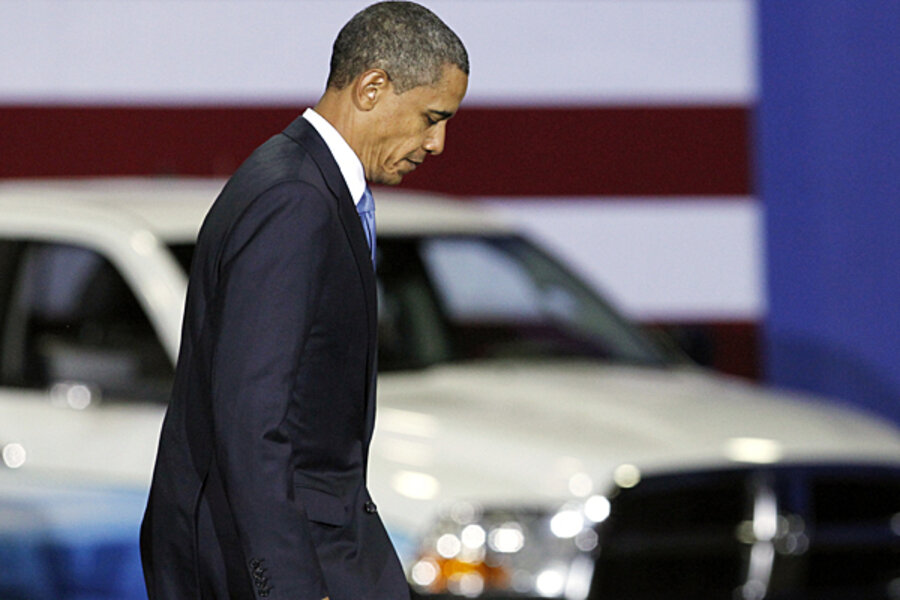Obama tightens truck fuel standards. Why efficiency matters.
Loading...
President Obama directed federal agencies Tuesday to develop and issue new medium- and heavy-duty vehicle fuel-efficiency and greenhouse-gas standards by March 2016. The new rules would build on standards passed in 2011 that are already projected to save vehicle owners and operators $50 billion in fuel costs and 530 million barrels of oil for the lifetime of models built from 2014 to 2018, according to the White House.
"Five years ago we set out to end our reliance on foreign oil and today America is closer to energy independence than it has been in decades," Mr. Obama said in an address at a Safeway distribution center in Upper Marlboro, Md., standing in front of one of the company's new fuel-efficient truck. "One of the reasons why is because we dedicated ourselves to manufacturing new cars and trucks that go farther on a gallon of gas. That saves families money, cuts down on harmful pollution and creates new technologies."
Truck fuel economy may not have the technological sheen of solar photovoltaics, or the geopolitical repercussions of North America's shale gas boom, but efficiency has played a big role in reducing foreign oil imports and cutting US carbon emissions. Saving more energy won't solve all of America's energy and climate challenges, but it is a rare, largely uncontroversial opportunity for Obama to advance both his environmental and economic goals.
"Strong heavy truck efficiency standards will not only cut carbon pollution that fuels climate change, but also save consumers money every time they go to a store and save truckers money at the pump," Frances Beinecke, president of the environmental group Natural Resources Defense Council, said in a statement Tuesday. "Just as clean car standards are revitalizing the American auto industry, which added more than 370,000 jobs, setting the bar higher for trucks will further encourage innovation in the industry."
Transportation is the second most energy-intensive sector of the US economy, behind electric power, according to the US Energy Information Administration (EIA). In 2010, heavy-duty vehicles made up just 4 percent of registered vehicles on US roads, according to the White House, but they accounted for 20 percent of on-road energy use and carbon emissions.
Cars have become more efficient since the 1970s, when Arab oil crises spurred decades of innovation in energy conservation. Between 1950 and 2011, US energy consumption per unit of gross domestic product decreased by 58 percent per real dollar of GDP, according to the EIA.
In his first term, Obama doubled fuel-economy standards for cars and light trucks, which the White House says will save consumers $1.7 trillion at the pump and slash greenhouse gas emissions by 6.6 billion tons over the life of the program.
Efficiency is not a silver bullet. Energy use is an open system, and barrels of oil saved in one sector or company may just show up as fuel burned somewhere else. Many economists warn of a "rebound effect": A driver who buys a more efficient car may end up driving more, thereby limiting or even canceling out the projected savings. And consumers and businesses are not always thrilled about paying more upfront, even if it means saving money in the long run.
Still, efficiency is one of the few parts of Obama's "all-of-the-above" approach to energy where he can get something close to resembling "all-of-the-above" support. Republicans and Democrats have a difficult time seeing eye-to-eye on controversial topics like the Keystone XL pipeline or power plant emissions standards, but they are more willing to reach across the aisle to save energy and money.
"[E]ven as we’ve increased energy production, we’ve partnered with businesses, builders, and local communities to reduce the energy we consume," Obama said in his State of the Union address last month. "When we rescued our automakers, for example, we worked with them to set higher fuel efficiency standards for our cars. In the coming months, I’ll build on that success by setting new standards for our trucks, so we can keep driving down oil imports and what we pay at the pump."








